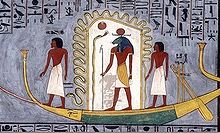
Anubis, also known as Inpu, Inpw, Jnpw, or Anpu in Ancient Egyptian is the god of funerary rites, protector of graves, and guide to the underworld, in ancient Egyptian religion, usually depicted as a canine or a man with a canine head.
Atum, sometimes rendered as Atem or Tem, is the primordial god in Egyptian mythology from whom all else arose. He created himself and is the father of Shu and Tefnut, the divine couple, who are the ancestors of the other Egyptian deities. Atum is also closely associated with the evening sun. As a primordial god and as the evening sun, Atum has chthonic and underworld connections. Atum was relevant to the ancient Egyptians throughout most of Egypt's history. He is believed to have been present in ideology as early as predynastic times, becoming even more prevalent during the Old Kingdom and continuing to be worshiped through the Middle and New Kingdom, though he becomes overshadowed by Re around this time.

Tefnut is a deity of moisture, moist air, dew and rain in Ancient Egyptian religion. She is the sister and consort of the air god Shu and the mother of Geb and Nut.

Amunet or Imnt ; also spelled Amonet or Amaunet; Koinē Greek: Αμαυνι) is a primordial goddess in ancient Egyptian religion. Thebes was the center of her worship through the last dynasty, the Ptolemaic Kingdom, in 30 BC. She is attested in the earliest known of Egyptian religious texts and, as was the custom, was paired with a counterpart who is entitled with the same name, but in the masculine, Amun. They were thought to have existed prior to the beginning of creation along with three other couples representing primeval concepts.

Seker is a hawk or falcon god of the Memphite necropolis in the Ancient Egyptian religion, who was known as a patron of the living, as well as a god of the dead.
Heka was the deification of magic and medicine in ancient Egypt. The name is the Egyptian word for "magic". According to Egyptian literature, Heka existed "before duality had yet come into being." The term ḥk3 was also used to refer to the practice of magical rituals.

Anuket was the ancient Egyptian goddess of the cataracts of the Nile and Lower Nubia in general, worshipped especially at Elephantine near the First Cataract.

Andjety is a local ancient Egyptian deity of the ninth nome, centered at Andjet, which was known as Busiris to the Greeks. This deity is also known by the alternative names Anezti or Anedjti. Andjety is considered one of the earliest Egyptian gods, possibly with roots in prehistoric Egypt.
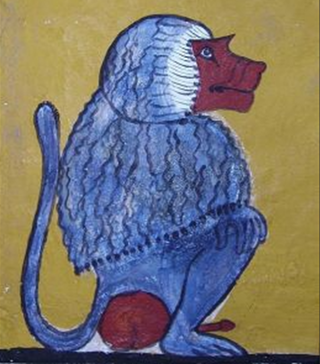
Babi, also Baba, in ancient Egyptian religion, was the deification of the hamadryas baboon, one of the animals present in ancient Egypt. His name is usually translated as "bull of the baboons", roughly meaning "chief of the baboons".
Montu was a falcon-god of war in the ancient Egyptian religion, an embodiment of the conquering vitality of the pharaoh. He was particularly worshipped in Upper Egypt and in the district of Thebes.
[Ramesses II] whom victory was foretold as he came from the womb,
Whom valor was given while in the egg,
Bull firm of heart as he treads the arena,
Godly king going forth like Montu on victory day.

In Egyptian mythology, Kebechet is a goddess, a deification of embalming liquid. Her name means cooling water.
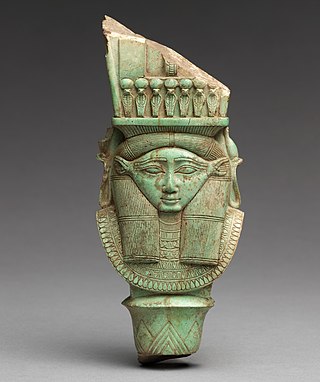
Bat is a cow goddess in Egyptian mythology who was depicted as a human face with cow ears and horns or as a woman. Evidence of the worship of Bat exists from the earliest records of the religious practices in ancient Egypt. By the time of the Middle Kingdom, after the unification of Lower Egypt and Upper Egypt, her identity and attributes were subsumed within that of the goddess Hathor, a similar goddess worshiped in another nome. The imagery of Bat persisted throughout the history of ancient Egypt on the sistrum, a sacred instrument that remained associated with religious practices.
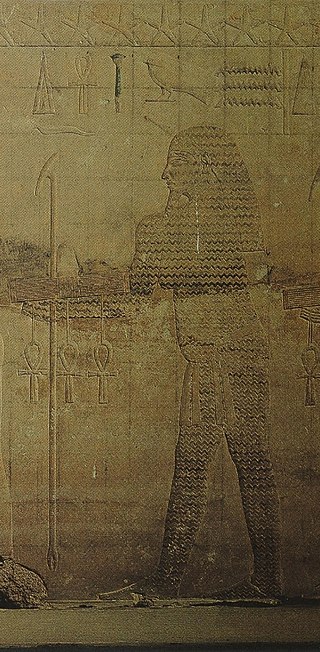
Wadj-wer, also spelled Uatch-ur is an Egyptian god of fertility and the personification of the Mediterranean Sea, whose name means the "great green". He also symbolizes the richness of the waters of the Nile Delta.
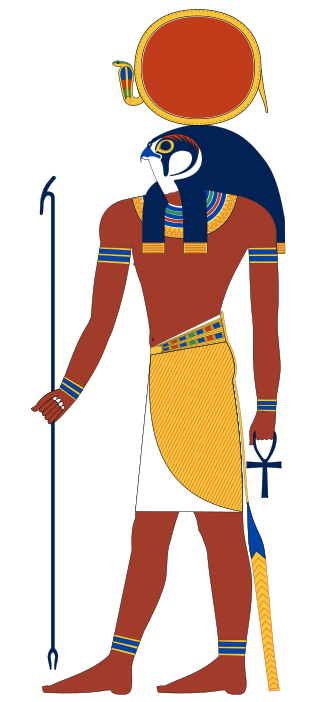
Ra or Re was the ancient Egyptian deity of the sun. By the Fifth Dynasty, in the 25th and 24th centuries BC, he had become one of the most important gods in ancient Egyptian religion, identified primarily with the noon-day sun. Ra ruled in all parts of the created world: the sky, the earth, and the underworld. He was believed to have ruled as the first pharaoh of Egypt. He was the god of the sun, order, kings and the sky.

Ancient Egyptian creation myths are the ancient Egyptian accounts of the creation of the world. The Pyramid Texts, tomb wall decorations, and writings, dating back to the Old Kingdom have provided the majority of information regarding ancient Egyptian creation myths. These myths also form the earliest religious compilations in the world. The ancient Egyptians had many creator gods and associated legends. Thus, the world or more specifically Egypt was created in diverse ways according to different parts of ancient Egypt. Some versions of the myth indicate spitting, others masturbation, as the act of creation. The earliest god, Ra and/or Atum, emerged from a chaotic state of the world and gave rise to Shu (air) and Tefnut (moisture), from whose union came Geb (earth) and Nut (sky), who in turn created Osiris, Isis, Set, and Nephthys. An extension to this basic framework was the Osiris myth involving Osiris, his consort Isis, and their son Horus. The murder of Osiris by Set, and the resulting struggle for power, won by Horus, provided a powerful narrative linking the ancient Egyptian ideology of kingship with the creation of the cosmos.

The Cavern deities of the underworld were ancient Egyptian minor deities charged with punishing the damned souls by beheading and devouring them.

The gate deities of the underworld were ancient Egyptian minor deities charged with guarding the gates of the Egyptian underworld.

The Assessors of Maat were 42 minor ancient Egyptian deities of the Maat charged with judging the souls of the dead in the afterlife by joining the judgment of Osiris in the Weighing of the Heart.
Renpetneferet is a minor goddess who is credited as being either the sister or the wife of Imhotep in Late Period Egyptian texts. There is no evidence of an individual by this name existing during the reign of King Djoser, although similar names were being used for women during the fourth dynasty.
